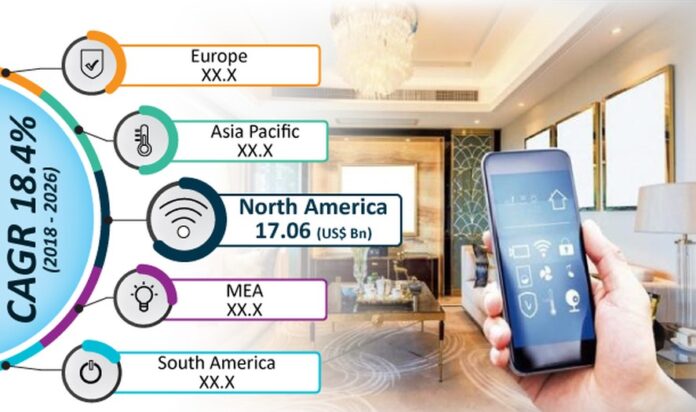
Smart home market promises new in-roads to players in the smart home market with rising demand for digital, and smart homes. The market remains a competitive, and vibrant landscape, with a large variety of companies making customised offering for buyers. Moreover, the barriers of high-costs to adoption are likely to go away in near future, as demand for additional digital security, entertainment systems, and lighting solution are making way for new opportunities to players in the smart home market.
According to TMR estimates, the smart home market will grow at a splendid 18.4% CAGR during 2018-2026 periods. The demand for lighting solution remains a major turn-on for end-consumers as these solutions can often be integrated without the burden of expensive technical setups. Moreover, these offer a premium convenience for buyers of controlling the ambience of their homes, offices while sitting in comfort, and gaining energy efficiency as a major bonus. Moreover, lights can also be switched on and off even remotely, which is another benefit of the lighting solutions.
Among regions, North America is expected to spearhead growth for smart homes, thanks to growing investment in technological advancement in the region, coupled with introduction of supporting mechanisms like 5G network. Asia Pacific region will likely register highest CAGR during 2018-2026, and take the smart home market to new heights, as large population of young buyers are likely to find major appeal in technological advancements
HVAC Control Systems Likely to Drive Major Growth
The smart home market is likely to witness major growth in near future in the HVAC systems. Despite several key advantages of lighting solutions, the sheer size, and potential of the HVAC segment is likely to overpower other segment in terms of total revenues. Moreover, countries like France, and Canada have passed roofs mandating green roofs in commercial complexes in major urban areas. The HVAC system also promise significant cost-saving potential for large commercial complexes, and the business sector is likely to happily absorb new costs as it promises maximum energy-savings in near future with use of sustainable energies like solar energy among others. The demand for smart security systems will also witness notable growth, as wireless connectivity, and increasing crime rates in non-gated communities, and urban areas prompt major security upgrades as the status for advanced security mechanisms continues to rise.
Manufacturing Industry to Remain a Major End-sector
Despite its name, the smart home market report will also cater to information from various end-industries. Among these, the manufacturing industry is likely to remain a major positive for the players in the smart home market. The major need for HVAC systems in the industry, and energy efficiency, and security needs, the industry is likely to move towards complete automation in the near future. The rising importance of automation, and solutions like centrally controlled HVAC and lighting solutions will drive growth for players in the smart home market.
The global smart home market can be segmented by:
Application
- Lighting Control
- Security and Access Control
- HVAC Control
- Entertainment Control
Region
- North America
- US
- Canada
- Europe
- Germany
- France
- Italy
- Spain
- U.K.
- Rest of Europe
- Middle East and Africa
- GCC Countries
- South Africa
- Rest of Middle East & Africa
- Asia Pacific
- China
- Japan
- India
- Australia & New Zealand
- Rest of Asia Pacific
- Latin America
- Brazil
- Mexico
- Rest of Latin America





